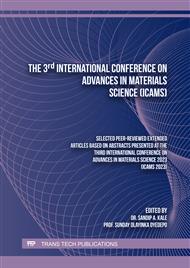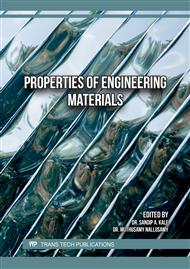[1]
R.B. Waterhouse, Fretting wear, Wear. 100 (1984) 107-118.
DOI: 10.1016/0043-1648(84)90008-5
Google Scholar
[2]
R.B. Waterhouse, Fretting Corrosion, Pergamon, Oxford, 1972.
Google Scholar
[3]
S. Shouyi, L. Li, Z. Yue et al., Fretting fatigue failure behavior of Nickel-based single crystal superalloy dovetail specimen in contact with powder metallurgy pads at high temperature, Tribology International. 142 (2020) Article 105986.
DOI: 10.1016/j.triboint.2019.105986
Google Scholar
[4]
D. Croccolo, M. De Agostinis, S. Fini, et al., Fretting fatigue in mechanical joints: A Literature Review, Lubricants. 10 (4) (2022) 53.
DOI: 10.3390/lubricants10040053
Google Scholar
[5]
A. Zabala, А. Aginagalde, W. Tato et al. Critical analysis of coefficient of friction derivation methods for fretting under gross slip regime, Tribology Inter. 142 (2020) Article 105988.
DOI: 10.1016/j.triboint.2019.105988
Google Scholar
[6]
J. Wang, D. Duan, W. Xue, S. Gao, S. Li, Ti-6Al-4V fretting wear and a quantitative indicator for fretting regime evaluation, Proc. Inst. of Mech. Eng., Part J: J. Eng. Tribology. 235 (2021) 423-433.
DOI: 10.1177/1350650120933115
Google Scholar
[7]
A. Wade, R. Copley, А.А. Omar et al., Novel numerical method for parameterising fretting contacts, Tribology Inter. 142 (2020) Article 105826.
DOI: 10.1016/j.triboint.2019.06.019
Google Scholar
[8]
H. Liu, X. Shao, K. Tan, et al., Microstructural evolution and oxidation in α/β titanium alloy under fretting fatigue loading. Friction (2023).
DOI: 10.1007/s40544-022-0729-z
Google Scholar
[9]
M. Lavella, D. Botto, Fretting wear of alloy steels at the blade tip of steam turbines, Wear. 426-427 (2019) 735–740.
DOI: 10.1016/j.wear.2019.01.039
Google Scholar
[10]
P.J. Blau, A microstructure-based wear model for grid-to-rod fretting of clad nuclear fuel rods, Wear. 426-427 (2019) 750–759.
DOI: 10.1016/j.wear.2019.01.056
Google Scholar
[11]
A. Siddaiah, A.K. Kasar, V. Khosla, P.L. Menezes, In-situ fretting wear analysis of electrical connectors for real system applications, J. Manuf. Mater. Process. 3 (2019) 47.
DOI: 10.3390/jmmp3020047
Google Scholar
[12]
J. Ke, X.B. Liu, J. Liang, L. Liang, Y.S. Luo, Microstructure and fretting wear of laser cladding self-lubricating anti-wear composite coatings on TA2 alloy after aging treatment. Opt. Laser. Technol. 119 (2019) 105599.
DOI: 10.1016/j.optlastec.2019.105599
Google Scholar
[13]
G. Wang, S. Wang, X. Yang, et al., Fretting wear and mechanical properties of surface-nanostructural titanium alloy bone plate, Surface and Coatings Technology. 405 (2021) 126512.
DOI: 10.1016/j.surfcoat.2020.126512
Google Scholar
[14]
Xu, Z.; Hu, N.; Lu, Y.; Xu,X. Effects of multi-axial compression on the mechanical and fretting wear properties of biocompatible Ti-45Nb alloys, Metals. 11 (2021) 454.
DOI: 10.3390/met11030454
Google Scholar
[15]
A.A. Misochenko, S.V. Chertovskikh, L.S. Shuster, V.V. Stolyarov, Influence of grain size and contact temperature on the tribological behaviour of shape memory Ti49.3Ni50.7 alloy, Tribology Letters, 65, (2017) 131
DOI: 10.1007/s11249-017-0917-6
Google Scholar
[16]
D.R. Barjaktarević, V.R. Djokić, J.B. Bajat, I.D. Dimić, I.L. Cvijović-Alagić, M.P. Rakin, The influence of the surface nanostructured modification on the corrosion resistance of the ultrafine-grained Ti–13Nb–13Zr alloy in artificial saliva, Theoretical and Applied Fracture Mechanics. 103 (2019) 102307.
DOI: 10.1016/j.tafmec.2019.102307
Google Scholar
[17]
J.E. Mogonye, T.W. Scharf, Tribological properties and mechanisms of self-mated ultrafine-grained titanium, Wear. 376–377 (2017) 931-939.
DOI: 10.1016/j.wear.2016.10.016
Google Scholar
[18]
M. Pakhomov, D. Gorlov, V. Stolyarov, Features of wear and friction in titanium, IOP Conf. Series: Mater. Sci. Eng., 996 (2020) 012017.
DOI: 10.1088/1757-899x/996/1/012017
Google Scholar
[19]
S. Kodirov, R.Z Valiev, G.I Raab, G.N Aleshin and A.G. Raab Structural features and mechanical properties of Grade 4 titanium from VSMPO-AVISMA (Russia) and Grade 4 titanium from Carpenter Technology Corporation (USA), subjected to ECAP-Conform 2019 IOP Conf. Ser.: Mater. Sci. Eng. 672 012016.
DOI: 10.1088/1757-899x/672/1/012016
Google Scholar
[20]
A. Balyanov, J. Kutnyakova, N.A. Amirkhanova, V.V. Stolyarov, R.Z. Valiev, X.Z. Liao, Y.H. Zhao, Y.B. Jiang, H.F. Xu, T.C. Lowe, Y.T. Zhu, Corrosion resistance of ultrafine-grained Ti, Scripta Materialia, 51 (2004) 225-229.
DOI: 10.1016/s1359-6462(04)00235-0
Google Scholar
[21]
L.M. Qian, Q.P. Sun, Z.R. Zhou, Fretting wear behavior of NiTi alloy, Tribology Letters, 18 (2005) 463-475.
DOI: 10.1007/s11249-005-3606-9
Google Scholar
[22]
Z.R. Zhou, L. Vincent, Mixed fretting regime, 181-183 (part-P2) (1995) 531–536.
DOI: 10.1016/0043-1648(95)90168-x
Google Scholar



